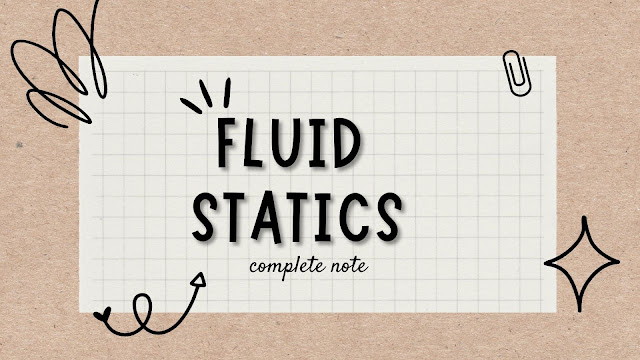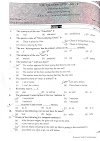Introduction
The branch of physics which deals with study of fluid at rest is called Hydrostatics.“Hydro”, meaning water/water like fluid“Statics”, meaning at rest
A fluid is a substance that flows from one point to another such as liquid and gas.
Density
The ratio of mass of a body to its volume is called density.Mathematically, Density(ρ)=Mass(m)/Volume(v)
When two liquids of equal volume are mixed whose densities are and :Density of mixture =
When two liquids of equal mass are mixed whose densities are and :Density of mixture =
Relative Density/Specific Gravity
Relative density is different from density. It’s the comparison of a substance’s density with density of pure water at 4 degree celsius.Ways to calculate relative density/specific gravity:
Specific Gravity= = density of water at 4 degree celsius is 1gm/cc(CGS unit)Specific Gravity =density of body(only when CGS unit is chosen)
Some other deviations of Specific Gravity:
Sp.Gr= x sp. gr of water at room temperatureSp.Gr(for a given liquid)=x sp. gr of water at room temperature.
Laws of liquid pressure
The pressure of a liquid is directly proportional to its density.
The pressure of a liquid is directly proportional to its depth from the free surface.
Pressure at a point in a liquid is the same in all directions.
Pressure of a liquid is independent of the shape of the vessel.
ARCHIMEDES’ PRINCIPLE
The principle states that , ‘When a body is partially or completely immersed in liquid then loss of weight of body is equal to weight of the displaced liquid.Mathematically, Loss of weight = weight of liquid displaced
An upward force acting on a body when it is partially or completely immersed.
According to Archimedes’ principle," Upthrust = wt. of liquid displaced""Upthrust = wt. of body in air - wt. of body in water"
Mathematically, Upthrust(U)= d.g.v(d= density of the liquid in which the body is)(v= volume of body inside the liquid)
Pascal’s Law
This is the law of transmission of liquid pressure.
The law states that pressure applied to an enclosed liquid(i.e liquid within a container like system), pressure is equally transmitted to every portion of the vessel/container.We get the relation (where and are forces and and are area of each opening)
Application of Pascal’s Law
Smaller force is magnified to a larger force. Force applied at the smaller opening magnifies to a larger magnitude at bigger opening, thus helping to lift heavier loads easily.
As pressure on both ends are equal(From Pascal’s law)( as is smaller and is larger is a bigger quantity )
Principle of Floatation
Considering a body of density is placed in a liquid of density then,
i.e wt. of body> upthrust , the body sinks i.e wt. of body= upthrust , the body just floats on the surface i.e wt. of body< upthrust , the body floats with certain part of it inside the liquid and certain part of it outside,fraction outside
Equilibrium in Floating Bodies
For a body such as a ship to keep floating, the Metacenter(MC) of the body should be above its Center of Gravity(CG), else it sinks.
Point of intersection of the line from CG and the line from Center of Buoyancy(CB). The geometric center of the submerged portion of the body.
Some Important points:
Liquid obeys volumetric conservation at all times under normal conditions.
If a body just floating in a liquid is pressed down and released it will sink.
Force of buoyancy depends on the mass of liquid displaced.
Apparent weight of a floating body is 0.
When an ice block floating in water melts the water level remains constant.
If ice containing metal floating in water melts, water level falls.
Even though g(acceleration due to gravity) varies, the barometric height remains constant.
If P is atmospheric pressure total pressure at depth h is
P’= P+ d.g.h



![[UPDATED] New Syllabus of IOE Entrance Examination |](https://blogger.googleusercontent.com/img/b/R29vZ2xl/AVvXsEj5C60n4l8guBTBqS4sBFaD1z9AoLPnKFQB_f1-F731bzrW_xcCsoewcBcUtqnpJhlf7lL5sOklAtsxRKdgZ-dCQiAgQb1T2X9ck-D_FYoU01fPdPA0mbsulZgmnkS-6-3Hg_CbxBExwn3z5c3-8srStMoZwr6SrmsgF5fPGjnD29T_lg1XsX3aZoIQm9k/w680/pic.png)


![[UPDATED] New Syllabus of IOE Entrance Examination |](https://blogger.googleusercontent.com/img/b/R29vZ2xl/AVvXsEj5C60n4l8guBTBqS4sBFaD1z9AoLPnKFQB_f1-F731bzrW_xcCsoewcBcUtqnpJhlf7lL5sOklAtsxRKdgZ-dCQiAgQb1T2X9ck-D_FYoU01fPdPA0mbsulZgmnkS-6-3Hg_CbxBExwn3z5c3-8srStMoZwr6SrmsgF5fPGjnD29T_lg1XsX3aZoIQm9k/w100/pic.png)


0 Comments